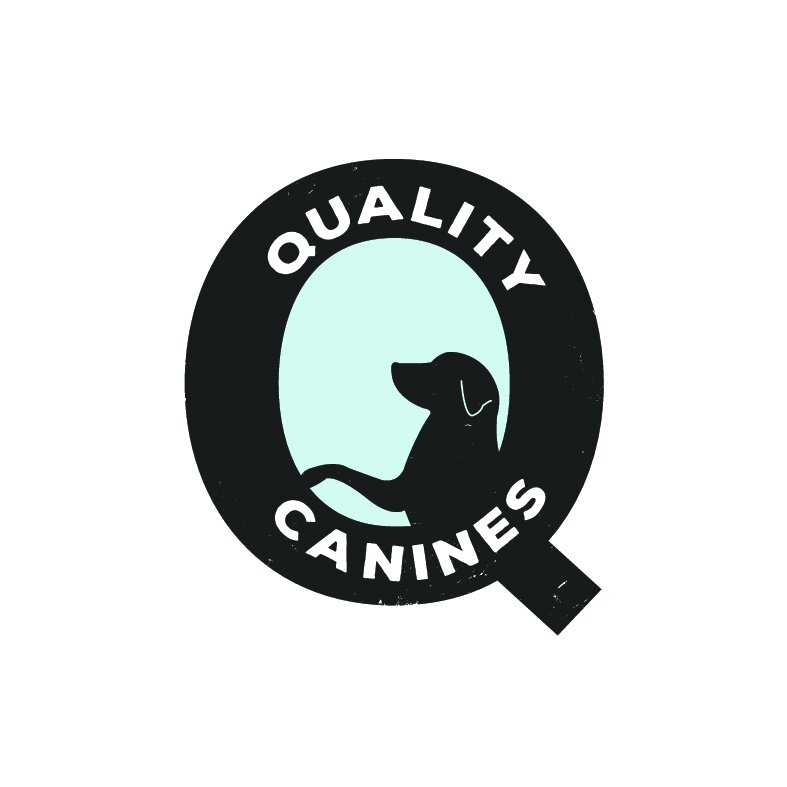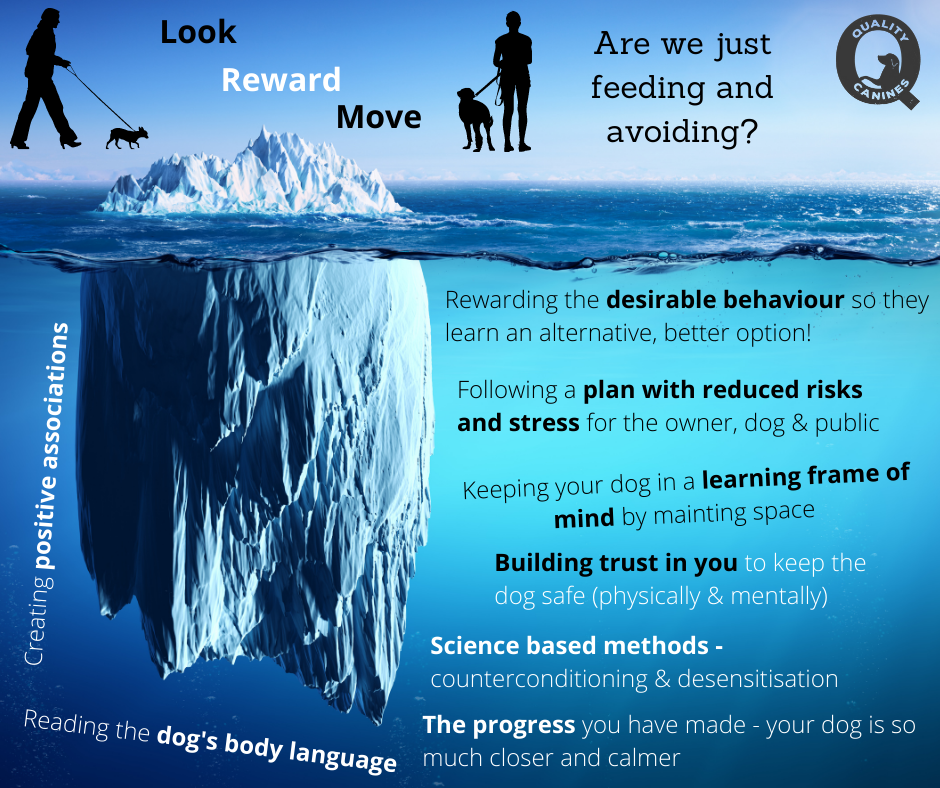Dealing with a Dog that Barks and Lunges on a Lead
Don’t Underestimate the Power of Space and Rewards
What people see may seem too simple but understanding what is happening underneath is where the beauty lies.
I have seen similar images created for a variety of topics and thought it is a perfect way of representing one of the methods commonly used for dealing with dogs that lunge and bark on their leads.
I want to spread more information regarding these techniques commonly used by reward based trainers and this image I created help summarise some of the main points.
When clients first come to me, they are often worried that they have made the problem worse by completely avoiding seeing people or dogs on their walks. Now although this won’t help the behaviour go away or get any better, it won’t necessarily make it worse. In some situations, this is actually better for me because it means that your dog hasn’t been continuously practicing the behaviour. The more they practice these behaviours the better they get at them, especially if it achieves exactly what they want it to achieve. For example, for a dog that is fearful, if every time they bark and lunge, the scary dog or person goes away and they remain safe, this will reward the behaviour and therefore the dog will keep doing this behaviour.
The aim of this blog post is to help you understand what is actually going on when a trainer asks you to maintain distance and reward your dog. We are not asking you to avoid and distract as this will achieve absolutely nothing!
Any good behaviourist/trainer will first of all assess your dog so they can understand what your dog’s motivation is (what are they trying to achieve with this behaviour) and also what is the underlying emotion behind this behaviour. Most commonly, dogs tend to lunge and bark on their lead either out of Frustration or Fear. For some dogs, it has just become a habit because they have been doing it that long, they do it without even thinking!
So lets dissect the image I have created further.
LOOK – REWARD – MOVE – What is this about?
Look – The dog needs to notice the thing (the “trigger”) that usually results in them lunging and barking. This is because we are trying to change their response to this trigger.
Reward – We may simply reward the dog with food or a toy (sometimes with space if that is what they are trying to achieve) as soon as they look at the person or dog. At this stage, we may be simply trying to reward looking and not lunging or barking, or we might be trying to pair up the person or dog with nice things to change their emotional response. This is where you need the help of a trainer/behaviourist because your timing and the distance you are at is vital (more on this later).
Move – This is all about maintaining the ideal space for your dog. If the person or dog is moving towards you and you stay still your dog will react with lunging and barking. As the training progresses we will be focusing on your dog being able to cope closer and closer.
So that’s all the things at the tip of the iceberg (what people see). So now lets have a look at some of the things that are also going on that people can’t see.
Rewarding the desirable behaviour – As mentioned earlier for some dogs we will be simply rewarding looking and not barking and lunging. Depending on the dog and why they are showing these undesirable behaviours we may also be teach an alternative behaviour. So we may teach the dog to see the “trigger” and then focus on the owner, once focused we may then just simply reward this or this may be what we get the dog to do in order to move closer to the “trigger”. This is for our frustrated dogs out there that just really want to say hello but when stopped they get annoyed so they bark and lunge. Allowing these dogs to greet to simply shut them up isn’t ideal as you are rewarding the lunging and barking! We may also simply allow them to see the dogs or people and then get them doing some obedience. This way those “triggers” are now just healthy distractions in the environment that your dog has learnt to ignore. A skill every dog should have in my opinion!
Creating positive associations – if your dog has been lunging and barking at things, I think everyone would agree that in that moment in time the dog isn’t feeling at its best! Using reward based training can really help set them up for success as instead of them dreading seeing the things that upset them, they will start associating it with fun things. Not only that, they start associating it with fun things with you! That brings with it so many more advantages!
Following a plan – A plan will be put together by your trainer. This is to allow you to get from A to B (dog lunging and barking to dog not lunging and barking) without you getting hurt, your dog getting hurt or anyone else getting hurt! This is essential not only for everyone’s welfare but it is also a legal requirement!!
A learning frame of mind – This is where the distance between your dog and the “trigger” is vital. Its not about avoiding the situations, its about keeping your dog under threshold so your dog can actually think and learn. Nobody makes good decisions when we have too much pressure on us and no time to think. When we are in these situations we do what we think is best and this decision is usually based on survival instincts or previous learning in those situations. So for your dog that lunges and barks, if they are too close, they are going to do what they know works best which is….lunge and bark! Also, when we are experiencing heightened stress or fear we do not learn very well at all and our dogs are the same. For this training to work your dog needs to be able to remember what you are doing and what they are being rewarded for so they can then repeat it the next time they are in that situation. This is the job of the trainer to help you get this bit right!
Building trust in you – If you get good at the training strategies set out by your trainer your dog will begin to trust you to deal with the situation. So instead of taking it into their own hands and lunging and barking, they will wait for you to move them. Don’t get me wrong, if they feel you aren’t dealing with it quick enough, they will step in. But again, this is where the distance comes in. It gives both you and the dog more time to think so you can get it right. Following a plan, your dog will soon start to look to you for guidance.
Science based methods – This technique is based on methods proven to work by science. I am not going to delve into this in this blog otherwise it will make this a very long one. For those of you that are interested, have a look into counter conditioning and desensitisation for dogs. A quick google search will bring up plenty of resources for you to read!
The progress – you may feel the technique is a little repetitive but that’s what makes it easy to implement and get right! But never forget how far you have come! Some dogs take a month to over come this behaviour others can take several months. This all depends on the dog’s history, why they are doing the behaviour, how long have they been practicing it and how consistent the training is. It is hard work and you can easily get disheartened if something happens that causes your dog to react and another person then looks at you with a displeasing look. Hold your head high and remember how far you have come. They don’t know that and I am sure if they understood they would be apologising to you for upsetting your dog rather than the other way round. My biggest tip here is to keep a diary! Even if it’s a simple as writing down how many “triggers” you saw on that walk and how many your dog didn’t lunge and bark at!
Last but not least, a person that goes through this training will develop an incredible skill!
Reading the dog’s body language – This is a skill that takes time and practice but your dog will show subtle signals that indicate how they are feeling and what their next move is about to be. A good trainer will point out these subtle signs to you so when you are out on your walks without your trainer you will spot the signs of your dog that is about to be pushed over threshold and is about to react. This is where you can quickly add in that space to prevent them from practicing that behaviour. This skill will also transfer into other scenarios which will only benefit you and your dog and will help grow your relationship. Nobody likes it when people don’t listen so its important we listen to our dogs too, we just have to learn to do it through our eyes instead of our ears. Here is a youtube video I created as part of a relationship building course that covers some of these subtle signals that can indicate stress. https://www.youtube.com/watch?v=q3mj5WyD8kQ&t=23s
Don’t give up hope! All these dogs did or can lunge or bark on the lead! Well done to all my dedicated owners and thank you for trusting in me!
That’s all on this for now, its such a huge topic! I hope this will help you understand some of the theory behind some of the methods commonly advised by a reward based trainer.
Please share this with anyone you feel may benefit from this and I would love to hear your thoughts and opinions on anything mentioned.
Natalie




